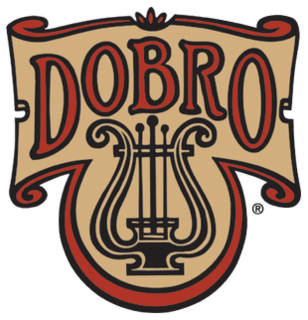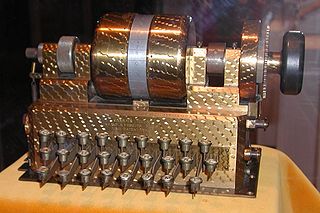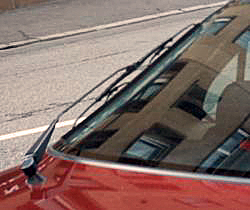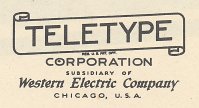Related Research Articles
Rickenbacker International Corporation is a string instrument manufacturer based in Santa Ana, California. The company is credited as the first known maker of electric guitars – a steel guitar in 1932 – and today produces a range of electric guitars and basses.

The 1880s was a decade of the Gregorian calendar that began on January 1, 1880, and ended on December 31, 1889.

Dobro is an American brand of resonator guitars, currently owned by Gibson and manufactured by its subsidiary Epiphone. The term "dobro" is also used as a generic term for any wood-bodied, single-cone resonator guitar.

The Hebern Rotor Machine was an electro-mechanical encryption machine built by combining the mechanical parts of a standard typewriter with the electrical parts of an electric typewriter, connecting the two through a scrambler. It is the first example of a class of machines known as rotor machines that would become the primary form of encryption during World War II and for some time after, and which included such famous examples as the German Enigma.

A windscreen wiper,windshield wiper or wiper blade is a device used to remove rain, snow, ice, washer fluid, water, and/or debris from a vehicle's front window. Almost all motor vehicles, including cars, trucks, buses, train locomotives, and watercraft with a cabin—and some aircraft—are equipped with one or more such wipers, which are usually a legal requirement.
Bulova is an American timepiece manufacturing company that was founded in 1875 and has been owned by Japanese multinational conglomerate Citizen Watch Co. since 2008. The company makes watches, clocks and accessories, and it is based in New York City.

The model 302 telephone is a desk set telephone that was manufactured in the United States by Western Electric from 1937 until 1955, and by Northern Electric in Canada until the late 1950s, until well after the introduction of the 500-type telephone in 1949. The sets were routinely refurbished into the 1960s. It was one of the most widely used American combined telephone sets to include the ringer and network circuitry in the same telephone housing.

Henry Dreyfuss was an American industrial design pioneer. Dreyfuss is known for designing some of the most iconic devices found in American homes and offices throughout the twentieth century, including the Western Electric Model 500 telephone, the Westclox Big Ben alarm clock, and the Honeywell round thermostat. Dreyfuss enjoyed long-term associations with several name brand companies such as John Deere, Polaroid, and American Airlines.

The Yellow Coach Manufacturing Company was an early manufacturer of passenger buses in the United States. Between 1923 and 1943, Yellow Coach built transit buses, electric-powered trolley buses, and parlor coaches.

Development of the automobile started in 1672 with the invention of the first steam-powered vehicle, which led to the creation of the first steam-powered automobile capable of human transportation, built by Nicolas-Joseph Cugnot in 1769. Inventors began to branch out at the start of the 19th century, creating the de Rivas engine, one of the first internal combustion engines, and an early electric motor. Samuel Brown later tested the first industrially applied internal combustion engine in 1826.

Arthur Atwater Kent Sr. was an American inventor and prominent radio manufacturer based in Philadelphia. In 1921, he patented the modern form of the automobile ignition coil.

Charles Francis Brush was an American engineer, inventor, entrepreneur, and philanthropist.

Westclox was an American manufacturer and is a current brand of clocks and alarm clocks. The company's historic plant is located in Peru, Illinois.

The Teletype Corporation, a part of American Telephone and Telegraph Company's Western Electric manufacturing arm since 1930, came into being in 1928 when the Morkrum-Kleinschmidt Company changed its name to the name of its trademark equipment. Teletype Corporation, of Skokie, Illinois, was responsible for the research, development and manufacture of data and record communications equipment, but it is primarily remembered for the manufacture of electromechanical teleprinters.

An electric clock is a clock that is powered by electricity, as opposed to a mechanical clock which is powered by a hanging weight or a mainspring. The term is often applied to the electrically powered mechanical clocks that were used before quartz clocks were introduced in the 1980s. The first experimental electric clocks were constructed around the 1840s, but they were not widely manufactured until mains electric power became available in the 1890s. In the 1930s the synchronous electric clock replaced mechanical clocks as the most widely used type of clock.
Telechron is the name of a U.S. company that manufactured electric clocks between 1912 and 1992. "Telechron" is derived from the Greek words tele, meaning "far off," and chronos, "time," thus referring to the transmission of time over long distances. Founded by Henry Ellis Warren, Telechron introduced the synchronous electric clock, which keeps time by the oscillations of the alternating current electricity that powers it from the electric power grid. Telechron had its heyday between 1925 and 1955, when it sold millions of electric clocks to American consumers.

A timeline of United States inventions (1890–1945) encompasses the ingenuity and innovative advancements of the United States within a historical context, dating from the Progressive Era to the end of World War II, which have been achieved by inventors who are either native-born or naturalized citizens of the United States. Copyright protection secures a person's right to his or her first-to-invent claim of the original invention in question, highlighted in Article I, Section 8, Clause 8 of the United States Constitution which gives the following enumerated power to the United States Congress:
To promote the Progress of Science and useful Arts, by securing for limited Times to Authors and Inventors the exclusive Right to their respective Writings and Discoveries.
The Singer Model 27 and later model 127 were a series of lockstitch sewing machines produced by the Singer Manufacturing Company from the 1880s to the 1960s.. They were Singer's first sewing machines to make use of "vibrating shuttle" technology. Millions were produced. They are all steel and cast iron, and were built before the advent of planned obsolescence, and so they were designed to be repaired rather than replaced. Consequently many remain today, some in collections and others still in service. In company literature they were called "the woman's faithful friend the world over".

Henry Ellis Warren was an American inventor credited with invention of the first synchronous electric clock which kept time from the oscillations of the power grid in 1918 as well as with 134 other inventions. Warren founded Warren Telechron Company in 1912 which later was acquired by General Electric in 1943. Warren was noted as the "father of electric time". Telechron went out of business in 1992. Just between 1916 and 1926 the company sold 20 million clocks. The clocks remained popular into the 1950s. In 1940 he also invented the "singing clock" which instead of a pendulum had a vibrating metal string.

George Walther Sr. was an American inventor, engineer, businessman, civic leader and the holder of over 100 patents for truck wheels, brake drums, fifth wheels, and landing gear/legs for the trucking industry. He was the founder of the Dayton Steel Foundry.
References
- ↑ Encyclopedia of Louisville, John Kleber, p. 507
- ↑ "Westclox Lasalle clock | Collectors Weekly".
- ↑ http://en.allexperts.com/q/Antique-Clocks-3526/2010/4/Telechron-Telalarm-Series.htm [ dead link ]